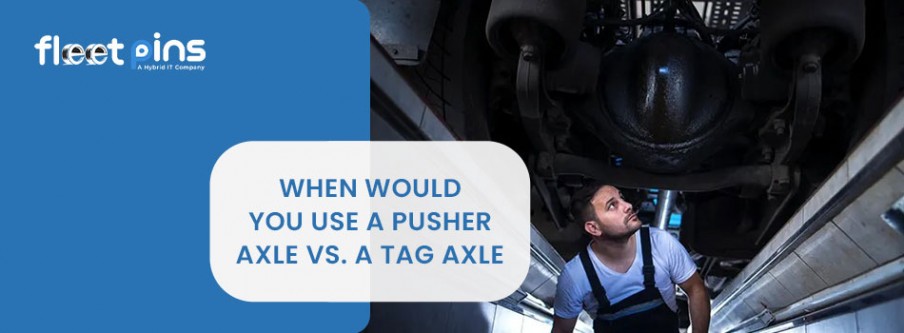
- On 2024-10-04
When to Use a Pusher Axle vs. a Tag Axle in Heavy-Duty Trucks
For heavy-duty trucks and trailers, the terms "pusher axle" and "tag axle" refer to additional axles installed on a vehicle to increase load capacity and improve stability. These axles are vital in distributing weight, complying with legal limits, and enhancing vehicle handling. However, the choice between a pusher axle and a tag axle depends on various factors, including the type of truck, its use, weight distribution, and other logistical needs. With fleet pins let’s breaks down what pusher and tag axles are, their differences, and when you would choose one over the other.
Understanding Pusher and Tag Axles
Before diving into when to use each type, let's clarify what these axles are and their primary functions.
What is a Pusher Axle?
A pusher axle is a non-driven axle located in front of the truck’s rear drive axle(s). It "pushes" weight toward the rear, helping distribute the truck's load more evenly.
- Location: Installed in front of the drive axle.
- Purpose: Primarily to increase the vehicle's gross weight capacity by distributing weight across multiple axles. By shifting more weight towards the rear, it reduces the load on the front axle.
- Steerability: Pusher axles can either be steerable or non-steerable, depending on the design.
What is a Tag Axle?
A tag axle, on the other hand, is located behind the truck’s drive axle(s). It "tags along" at the rear of the vehicle, helping support additional weight.
- Location: Positioned behind the drive axle.
- Purpose: Similar to the pusher axle, the tag axle helps increase the vehicle's weight capacity and helps maintain stability by spreading the load over more axles.
- Steerability: Tag axles are typically non-steerable, meaning they don't turn with the vehicle's front wheels.
Differences Between Pusher and Tag Axles
Both axles help in load distribution, but their placement and effects on vehicle handling differ significantly. Here are the key differences:
Pusher and tag axles both play a vital role in distributing the weight of heavy vehicles, but they differ significantly in terms of placement and impact on vehicle handling. A pusher axle is installed in front of the drive axle, while a tag axle is located behind it. This positioning affects how weight is distributed; a pusher axle shifts weight forward, reducing the load on the front axle. Whereas a tag axle provides additional support behind the drive axle, helping to stabilize the rear and prevent overloading on the drive axle.
In terms of vehicle handling, a pusher axle has a more noticeable impact due to its position ahead of the drive axle, potentially reducing the vehicle's turning radius, especially if it's non-steerable. Conversely, a tag axle, being placed at the rear, doesn't significantly affect handling and allows for smoother turns. In terms of application, pusher axles are often used in vocational trucks such as dump trucks and concrete mixers, where maneuverability is crucial. On the other hand, tag axles are more common in highway trucks and buses, where load stability and capacity are prioritized over tight turning capabilities.
When Would You Use a Pusher Axle?
A pusher axle is ideal when the vehicle carries loads that are often positioned further forward. By shifting weight towards the rear, a pusher axle helps prevent overloading of the front axle, which can be critical for maintaining proper steering and avoiding premature wear on front tires.
When Maneuverability is Key
In vehicles that need to navigate tight spaces or job sites, such as construction vehicles or vocational trucks, a steerable pusher axle can provide better weight distribution without significantly compromising turning ability.
For Improved Load Capacity
Pusher axles are great for situations where you need to increase the gross vehicle weight rating (GVWR) of the truck but still need a good balance of weight across the vehicle. These axles are often used in trucks that need to haul heavy materials in urban areas or job sites where tight turns are necessary.
When Carrying Mixed Loads
Pusher axles can be beneficial when the truck's load varies in weight and position. It allows for flexibility in distributing the weight across the axles, making it useful for trucks that may not always have the same load configuration.
When Would You Use a Tag Axle?
A tag axle is typically used in vehicles that prioritize stability at higher speeds, such as highway trucks, long-haul trailers, and buses. Since it’s placed behind the drive axle, it helps provide additional weight support without affecting the steering dynamics of the vehicle.
For Heavy Loads on Smooth Roads
Tag axles are ideal for trucks and buses that operate on highways and smoother roads. These axles help in distributing the load evenly across the rear of the truck, which can be particularly useful when you need to transport heavy materials over long distances.
When Turning Radius is Not a Major Concern
If the vehicle mostly operates on straight roads, highways, or wide-open spaces where turning is not a primary concern, a tag axle may be the better option. Since its non-steerable, it won't interfere with the truck’s ability to turn sharply, but it does provide the benefit of extra load capacity.
In Bus and Trailer Applications
Tag axles are frequently found in buses and large trailers because they provide needed stability and weight capacity without affecting the handling dynamics that are critical in passenger transport or towing large loads.
Factors to Consider When Choosing Between a Pusher and Tag Axle
- Load Distribution Requirements
- Operational Terrain
- Legal Weight Limits
- Maintenance Considerations
Choose the Right Axle with Fleet Management Software
Choosing the right axle fleet management software like Fleet Pins is crucial for optimizing the performance and efficiency of your fleet. The ideal software should offer features like real-time tracking, axle weight monitoring, maintenance and scheduling. Also deal in compliance with legal weight limits to ensure safety and prevent fines. It should also provide detailed analytics to help fleet managers make informed decisions about vehicle load distribution, fuel efficiency, and maintenance needs.
By integrating the right software, you can maximize the lifespan of your vehicles, improve overall fleet productivity, and reduce operational costs.
Conclusion
Both pusher and tag axles serve to increase the load capacity of heavy vehicles. But their application depends on the specific requirements of the vehicle and the environment in which it operates. Pusher axles are best suited for trucks that require better weight distribution and maneuverability, making them ideal for vocational and construction vehicles. Tag axles, on the other hand, provide enhanced stability and weight capacity, making them perfect for highway trucks and buses.
When choosing between the two, consider factors such as load distribution, operational terrain, and vehicle handling to make the best decision for your needs.




